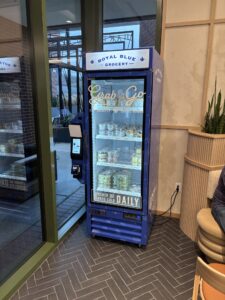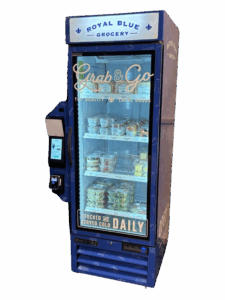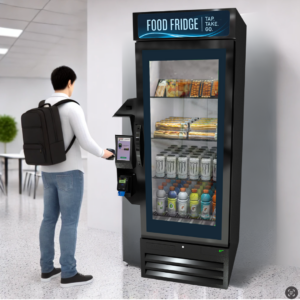Understanding RFID Vending Micro Markets
 The term "micro market" has evolved significantly in the workplace refreshment industry. While these traditionally resembled miniature convenience stores with open shelving and central checkout kiosks, modern RFID vending micro markets represent a technological leap forward—combining the convenience and variety of traditional models with the security, efficiency, and space optimization of advanced vending technology.
The term "micro market" has evolved significantly in the workplace refreshment industry. While these traditionally resembled miniature convenience stores with open shelving and central checkout kiosks, modern RFID vending micro markets represent a technological leap forward—combining the convenience and variety of traditional models with the security, efficiency, and space optimization of advanced vending technology.
An RFID vending micro market uses Radio Frequency Identification (RFID) technology to create a self-service fresh food retail experience through one or multiple smart vending units. Unlike traditional open-shelf versions that require 200-500 square feet and face significant shrinkage challenges, RFID vending micro markets deliver the same fresh food variety and 24/7 access in a secure, automated, and space-efficient format.
For organizations seeking to provide employees, students, patients, or guests with convenient access to fresh, healthy food, understanding how RFID vending micro markets work—and how they differ from older sales models—is essential for making informed decisions.
How RFID Vending Micro Markets Work
RFID vending micro markets leverage sophisticated technology to automate the entire transaction process while maintaining precise inventory control and food safety standards.
RFID Technology: The Foundation
At the core of every RFID vending micro market is Radio Frequency Identification technology. Here's how it functions:
Product Tagging: Each food item in the vending machine is tagged with a small RFID chip containing critical information:
- Product identification and description
- Price
- Nutritional data
- Production date
- Expiration date
- Allergen information
Automated Scanning: When items are stocked in the vending unit, RFID readers automatically scan and log every product. This instant inventory update occurs without manual data entry or barcode scanning, dramatically reducing labor requirements and human error.
Transaction Processing: When a customer makes a purchase, the RFID system:
- Detects which items are removed from the unit
- Automatically calculates the total cost
- Processes payment through integrated systems
- Updates inventory in real-time
- Records the transaction for analytics and reporting
Inventory Intelligence: The RFID system continuously monitors:
- Current stock levels for each product
- Which items are selling quickly vs slowly
- Expiration dates approaching for all perishables
- Temperature fluctuations that could impact food safety
- Transaction patterns revealing peak usage times
This level of automation and intelligence creates operational efficiency impossible with traditional micro markets or older vending technology.
The Customer Experience
From the user perspective, RFID vending micro markets offer an intuitive, frictionless experience:
Interactive Touchscreen Interface: Customers interact with a large, user-friendly touchscreen displaying:
- Full-color product photos
- Detailed nutritional information (calories, protein, carbs, fats)
- Ingredient lists and allergen warnings
- Pricing
- Dietary filtering options (vegetarian, vegan, gluten-free, etc.)
Simple "Tap, Take, Go" Process: Rather than entering selections via buttons or keypads, customers simply:
- Tap their payment method (credit card, mobile payment, employee badge)
- Open the unit and take desired items
- Close the door—the RFID system automatically detects items removed
- Transaction completes instantly
This streamlined process takes seconds and eliminates the frustration of items getting stuck in traditional vending machines.
Multiple Payment Options: Modern RFID vending micro markets support diverse payment methods:
- Credit and debit cards
- Contactless payments (Apple Pay, Google Pay)
- Mobile payment apps
- Employee badge or ID card systems
- University meal plan cards
- Custom payment integrations
Temperature Control & Food Safety
Fresh food vending quality depends on consistent temperature management. RFID vending micro markets incorporate commercial-grade refrigeration systems that:
Maintain Optimal Temperatures: Refrigerated units maintain temperatures between 34-38°F, the ideal range for preserving fresh food quality and safety.
Continuous Monitoring: Integrated sensors track temperature 24/7, with automatic alerts if conditions fluctuate outside acceptable ranges.
Automated Responses: In the event of temperature deviations or power failures, units automatically lock to prevent food safety issues and protect product quality.
Food Rotation Management: RFID technology ensures first-in, first-out rotation, with the system prioritizing older inventory for sale while flagging items approaching expiration dates for removal.
 Single Unit vs Multi-Unit Configurations: Scalable Solutions
Single Unit vs Multi-Unit Configurations: Scalable Solutions
One of the key advantages of RFID vending micro markets is modularity. Organizations can configure solutions based on their specific space, population, and variety requirements.
Single Unit Configuration
Best for: 25-75 regular users, limited space availability, focused product selection
A single RFID vending unit typically provides:
- Capacity: 40-60 product positions
- Footprint: 10-15 square feet
- Product Focus: Core fresh food items (sandwiches, salads, wraps, yogurt, fruit)
- Setup Time: 1-2 days
- Investment: $7,500 for equipment
Single unit configurations work exceptionally well for:
- Small office locations
- Satellite facilities
- Building lobbies
- Specific departments within larger organizations
- Testing market demand before expansion
Two-Unit Configuration
Best for: 75-150 regular users, moderate space availability, expanded variety needs
Combining two RFID vending units creates enhanced capabilities:
- Capacity: 80-120 product positions
- Footprint: 20-30 square feet
- Product Diversity: Fresh food + beverages, or fresh + frozen options
- Temperature Zones: Refrigeration + ambient or freezer combinations
- Investment: $15000 for equipment
Two-unit configurations provide:
- Greater product variety without excessive space requirements
- Ability to separate food categories (meals vs snacks, breakfast vs lunch)
- Redundancy—if one unit requires service, the other remains operational
- Higher total capacity to reduce restocking frequency
Three+ Unit Configuration: The Full Micro Market Experience
Best for: 150+ regular users, desire for extensive variety, available floor space
Three or more RFID vending units placed together create a true micro market experience:
- Capacity: 120-180+ product positions
- Footprint: 30-45 square feet (still far less than traditional micro markets)
- Product Range: Comprehensive fresh food, beverages, snacks, frozen meals
- Temperature Flexibility: Multiple refrigeration zones plus ambient and freezer options
- Investment: $22,500 for equipment
Example Three-Unit Micro Market Configuration:
Unit 1 - Smart Fresh Food Fridge:
- Sandwiches, wraps, salads
- Fresh fruit cups and vegetables
- Greek yogurt and parfaits
- Protein-packed snacks
Unit 2 - Smart Beverage & Snack Cabinet:
- Bottled beverages (water, juice, tea, coffee)
- Protein bars and energy bars
- Healthy snack options
- Grab-and-go breakfast items
Unit 3 - Smart Freezer:
- Frozen meals and entrees
- Ice cream and frozen treats
- Specialty frozen items
- Bulk frozen products
This configuration delivers micro market variety and choice while maintaining RFID technology advantages: almost no shrinkage, precise inventory management, and compact footprint.
Scalability: Start Small, Expand as Needed
Unlike traditional micro markets that require significant upfront space and infrastructure investment, RFID versions offer genuine scalability:
Phase 1: Start with one unit serving 50 employees
Phase 2: Add second unit as population grows to 100 employees
Phase 3: Expand to three-unit configuration when reaching 150+ employees
Phase 4: Place additional single units in distributed locations throughout facility
This modular approach allows organizations to:
- Test market demand before major investment
- Match capacity precisely to actual usage
- Adjust product mix based on sales data
- Expand incrementally as budget and space allow
- Avoid over-committing to infrastructure that may exceed actual needs
 Key Benefits of RFID Vending Micro Markets
Key Benefits of RFID Vending Micro Markets
Modern RFID vending micro markets deliver advantages that traditional open-shelf models and conventional vending machines cannot match.
Zero Shrinkage & Theft Prevention
The Challenge: Traditional open-shelf micro markets experience 2-5% inventory loss from theft, miscounted items, and accounting errors. In a facility doing $100,000 annual sales, this represents $2,000-$5,000 in losses.
The RFID Solution: Enclosed units with RFID tracking eliminate theft entirely. Products cannot be removed without payment, and the system automatically detects and records every item taken. This near-zero shrinkage protects both service provider profitability and keeps prices competitive for customers.
24/7 Automated Operation
RFID vending micro markets operate continuously without human supervision:
- No staff required to monitor or operate the micro market, unless unit is self-managed and stocked
- No access control decisions about who can use the space when
- No cleaning or maintenance responsibilities for the organization, unless self-managed
- Service providers handle all restocking, maintenance, and management
This automation makes fresh food accessible to second and third shift workers, weekend staff, and anyone working outside traditional business hours—without requiring organizations to staff or monitor the space.
Space Efficiency
Footprint Comparison:
- Traditional micro market: 200-500 square feet
- Three-unit RFID micro market: 30-45 square feet
- Single RFID unit: 10-15 square feet
For organizations where real estate is expensive or space is limited, this efficiency is transformative. A three-unit RFID micro market occupies less than 10% of the space required by traditional models while delivering comparable product variety.
Precise Inventory Management & Waste Reduction
RFID technology enables inventory management impossible with manual systems:
Real-Time Visibility: Operators know exactly what's in stock, what's selling, and what needs replenishing—updated after every transaction.
Expiration Tracking: Automated monitoring of expiration dates prevents expired items from being available for sale and alerts operators when products need removal.
Data-Driven Restocking: Service providers stock based on actual consumption patterns rather than estimates, reducing waste from overstocking slow-moving items.
First-In, First-Out Rotation: The system prioritizes older inventory for sale, ensuring products are consumed before expiration.
According to food waste studies, this precision can reduce waste by 30-50% compared to manual inventory systems, supporting both profitability and environmental sustainability.
Customization & Menu Flexibility
RFID vending micro markets offer extensive customization options:
Location-Specific Menus: Each installation can be tailored to the specific preferences and dietary needs of its user population. An office building in a tech hub might stock different items than a healthcare facility or university campus.
Seasonal Adjustments: Product offerings can shift seasonally—lighter salads and cold soups in summer, heartier grain bowls and warm options in winter.
Dietary Accommodation: Units can stock products meeting diverse needs:
- Vegetarian and vegan options
- Gluten-free selections
- Dairy-free alternatives
- Low-carb and keto-friendly items
- Allergen-free products
- Halal or kosher certified items where required
Responsive Menu Changes: Sales data reveals what's working and what's not. Service providers can quickly adjust offerings based on actual purchasing behavior rather than assumptions.
Enhanced Security & Reliability
Physical Security: Enclosed units protect products from tampering, contamination, or accidental damage that can occur in open-access environments.
Power Failure Protection: In the event of power outages, units remain locked until power is restored, protecting food safety and preventing loss.
Remote Monitoring: 24/7 connectivity enables immediate alerts for any issues—temperature fluctuations, payment system problems, or connectivity issues—allowing rapid response before problems affect customers.
Quality Assurance: Controlled environment ensures consistent product quality, proper temperature maintenance, and food safety compliance.
Ideal Applications for RFID Vending Micro Markets
RFID vending micro markets serve diverse environments effectively:
 Corporate Offices
Corporate Offices
Provide employees with convenient access to fresh, healthy meals without leaving the building:
- Reduces time away from work for lunch
- Supports wellness programs with nutritious options
- Accommodates varied schedules and preferences
- Demonstrates organizational commitment to employee well-being
Healthcare Facilities
Serve patients, visitors, and healthcare workers around the clock:
- Critical for 24/7 hospital operations
- Provides nutritious options for staff working long shifts
- Convenient for visitors spending extended hours at facilities
- Supports dietary requirements and restrictions
Educational Institutions
Offer students flexible food access aligned with academic schedules:
- Operates when dining halls are closed
- Accommodates irregular student schedules
- Provides healthier alternatives to off-campus fast food
- Supports student meal plans and payment systems
Hotels & Hospitality
Enhance guest experience with convenient food options:
- Complements or replaces traditional convenience stores
- Operates 24/7 without staffing requirements
- Offers fresh, appealing options beyond typical hotel vending
- Creates modern, upscale impression
Manufacturing & Industrial Facilities
Serve shift workers with limited food service alternatives:
- Provides fresh meal access for all shifts
- Operates in break rooms or cafeteria spaces
- Supports productivity with convenient meal options
- Reduces need for workers to leave premises
Transportation Hubs
Provide travelers with quick, healthy food access:
- Operates continuously without staff
- Offers alternatives to expensive concessions
- Serves diverse populations efficiently
- Generates revenue while serving customer needs
Choosing the Right Configuration for Your Organization
Several factors determine the optimal RFID vending micro market configuration:
Population Analysis
25-75 regular users: Single unit configuration typically sufficient
75-150 regular users: Two-unit configuration provides enhanced variety
150+ regular users: Three or more units create full micro market experience
Consider not just total population, but actual usage patterns. A facility with 200 employees where only 25% regularly purchase on-site food might succeed with a single or two-unit configuration.
Space Availability
10-15 sq ft available: Single unit
20-30 sq ft available: Two-unit configuration
30-45+ sq ft available: Full three-unit micro market
Also consider:
- Electrical access for each unit
- Network connectivity requirements
- Traffic flow and accessibility
- Proximity to break rooms or gathering spaces
 Product Variety Requirements
Product Variety Requirements
Core fresh food focus: Single refrigerated unit
Fresh food + beverages: Two units (refrigerated food + ambient cabinet)
Comprehensive selection: Three units (fresh + beverages/snacks + frozen)
Survey employees or users about preferences to inform configuration decisions.
Ongoing Costs:
- Technology support: ~$200/month per unit
- Transaction fees: $0.25 + merchant fees per transaction
- RFID tags: ~$0.18 per tag
- Restocking and service: Typically covered through product markup
Many organizations work with service providers who place equipment at no upfront cost, recovering investment through product sales. REDYREF also offers financing options making equipment acquisition accessible.
Growth & Scalability
Start with the configuration meeting immediate needs, with clear expansion pathway:
- Begin with one unit to test demand
- Add second unit once consistent utilization is demonstrated
- Expand to three-unit configuration as population or demand grows
- Place additional single units in distributed locations throughout larger facilities
Why Manufacturing Experience Matters
When choosing an RFID vending micro market provider, manufacturing expertise and longevity provide critical advantages:
REDYREF's 100+ Years of Kiosk Manufacturing Experience
REDYREF brings over a century of kiosk design, engineering, and manufacturing expertise to every fresh food vending solution. This experience translates directly to product quality, reliability, and customization capabilities.
Proven Manufacturing Excellence:
- ISO 9001:2015 certified manufacturing processes
- In-house design, engineering, and production capabilities
- Rigorous quality control standards
- Extensive testing protocols ensuring reliability
Deep Industry Knowledge: Over 100 years in the industry means REDYREF has:
- Solved countless installation challenges across diverse environments
- Refined designs based on real-world performance data
- Built relationships with component suppliers ensuring quality
- Developed troubleshooting protocols from decades of service experience
In-House Manufacturing Enables Customization
Unlike providers who source units from third-party manufacturers, REDYREF's in-house production capabilities enable:
Custom Configurations:
- Modified dimensions to fit specific spaces
- Custom exterior finishes and branding
- Specialized hardware integrations
- Unique payment system requirements
Rapid Prototyping: When organizations have special needs, REDYREF can design, prototype, and test custom solutions efficiently.
Quality Control: Direct oversight of manufacturing ensures consistent quality and allows immediate correction of any issues discovered during production.
Support & Service: In-house manufacturing means REDYREF technicians understand every component of the systems they service, enabling faster, more effective support.
Comprehensive Product Portfolio
REDYREF's experience extends far beyond fresh food vending. The company manufactures:
This breadth of experience means REDYREF understands kiosk technology holistically—user experience design, payment system integration, network connectivity, accessibility requirements, and environmental considerations—all of which enhance fresh snack and meal vending solutions.
Long-Term Partnership & Support
Organizations making significant investments in workplace amenities need confidence their provider will be there for the long term. REDYREF's century-plus track record provides assurance that:
- Parts and service will remain available
- Technology updates and improvements continue
- Support infrastructure is established and reliable
- Business stability ensures ongoing partnership
Frequently Asked Questions About RFID Vending Micro Markets
How is this different from traditional vending machines?
Traditional vending machines use mechanical or weight-based systems to dispense products, with limited intelligence about inventory or customer preferences. RFID vending micro markets use advanced technology to automatically track every item, manage expiration dates, provide detailed nutritional information, and eliminate theft—all while offering fresh, healthy food rather than just snacks and beverages.
How often are units restocked?
Fresh food RFID vending micro markets typically receive restocking 2-3 times per week to ensure maximum freshness. The RFID system tracks inventory in real-time and alerts operators when popular items need replenishment or products are approaching expiration dates.
What happens if items reach their expiration date?
The RFID system automatically monitors expiration dates for all products. Operators receive alerts when items are nearing expiration, allowing removal before they become unavailable for sale. This ensures customers always access fresh, safe products.
Can we customize what products are offered?
Absolutely. One of the key advantages of fresh food vending micro markets is complete menu customization. Organizations work with service providers to select initial offerings, then adjust based on sales data, employee feedback, and changing preferences. Product mix can be updated as frequently as needed.
How much space do we need?
Space requirements depend on configuration:
- Single unit: 10-15 square feet
- Two units: 20-30 square feet
- Three units: 30-45 square feet
Each unit also requires electrical access (standard 110V outlet) and network connectivity (WiFi or cellular).
What if we don't have enough employees to justify a full micro market?
The modular approach solves this challenge. Organizations with as few as 25-50 regular users can successfully operate a single RFID vending unit. As population or demand grows, additional units can be added incrementally.
How do costs compare to traditional micro markets?
RFID vending micro markets typically have lower total costs than traditional open-shelf versions:
- Lower equipment costs ($7,500-$22,500 vs $15,000-$50,000+)
- Minimal space requirements (saving real estate opportunity costs)
- Nearly zero shrinkage (eliminating 2-5% inventory losses)
- Less frequent restocking required (lower service costs)
- No organizational cleaning/maintenance responsibilities
Can employees use their ID badges or meal cards for payment?
Yes. RFID vending micro markets support custom payment integrations including:
- Employee ID badge systems
- University meal plan cards
- Corporate payment accounts
- Pre-loaded vending cards
- Standard credit/debit and mobile payments
What about dietary restrictions and allergies?
The touchscreen interface displays detailed nutritional information, ingredient lists, and allergen warnings for every product. Customers can filter menu options by dietary preference (vegetarian, vegan, gluten-free, dairy-free, etc.). Additionally, product offerings can be customized to ensure appropriate options for your specific population.
How long does installation take?
Single or two-unit installations can generally be completed in about an just a couple of hours. Three-unit configurations may require a day. This includes:
- Physical placement and setup
- Electrical connection
- Network configuration
- Initial product stocking
- Staff orientation on basic operations
Transform Your Workplace with RFID Vending Micro Markets
Fresh food vending micro markets represent the evolution of workplace food service—combining the variety and convenience of traditional models with the efficiency, security, and space optimization of advanced vending technology. Whether your organization needs a single unit serving a small team or a full three-unit configuration creating a comprehensive micro market experience, REDYREF's modular approach provides the flexibility to match your exact requirements. With over 100 years of kiosk manufacturing experience, in-house production capabilities, and proven expertise across diverse industries, REDYREF delivers solutions built to perform reliably for years while adapting to your changing needs.
Ready to explore how RFID vending micro markets can serve your organization? Contact REDYREF today to discuss your specific needs, space constraints, and goals. Our team will work with you to design the optimal fresh food solution—whether that's a single Fresh Food Fridge, a multi-unit configuration, or a custom solution tailored to your unique requirements.
Let's work together to bring convenient, healthy, fresh food access to your workplace.

 The term "micro market" has evolved significantly in the workplace refreshment industry. While these traditionally resembled miniature convenience stores with open shelving and central checkout kiosks, modern RFID vending micro markets represent a technological leap forward—combining the convenience and variety of traditional models with the security, efficiency, and space optimization of advanced vending technology.
The term "micro market" has evolved significantly in the workplace refreshment industry. While these traditionally resembled miniature convenience stores with open shelving and central checkout kiosks, modern RFID vending micro markets represent a technological leap forward—combining the convenience and variety of traditional models with the security, efficiency, and space optimization of advanced vending technology. Single Unit vs Multi-Unit Configurations: Scalable Solutions
Single Unit vs Multi-Unit Configurations: Scalable Solutions Key Benefits of RFID Vending Micro Markets
Key Benefits of RFID Vending Micro Markets Corporate Offices
Corporate Offices Product Variety Requirements
Product Variety Requirements